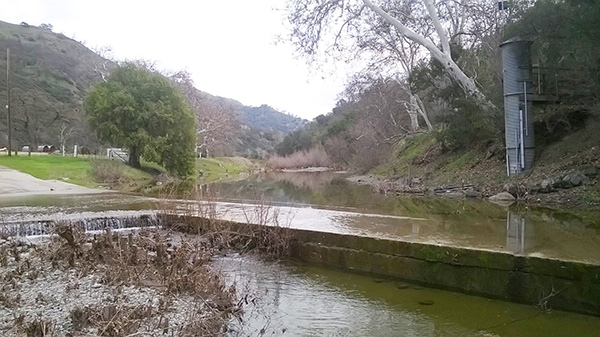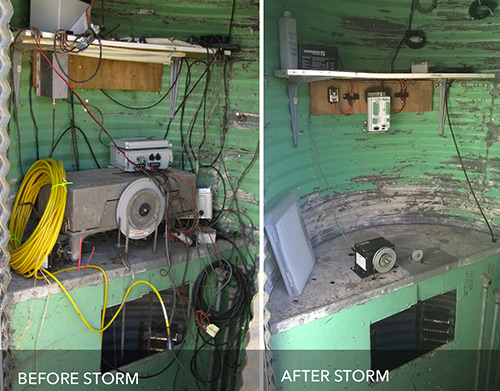Early Flood Warning with Water Monitoring Instruments
In Alameda County, located in the eastern portion of the San Francisco Bay area, Zone 7 Water Agency has utilized the latest water level technology to monitor streamflow.
The results of their Surface Water Program, which utilizes a central data web access server, Storm 3 Data Loggers, Water Level Bubblers, Submersible Pressure Transducers, and a SonTek-IQ Pipe acoustic flow meter, will provide early flood warning and shed new light on streamflow monitoring for the San Francisco Bay area.
The Challenge
Data from the Surface Water Program is used in maintaining Arroyo Del Valle Water Rights and habitat sustainability, quantifying inflow/outflow of surface water for Livermore-Amador Valley and assisting in hydrologic modeling of the watershed for flood control management purposes.
Though the program is seeing a positive result, water level monitoring is not without its trials. The Zone 7 Water Agency Surface Water Program operates ten stream gages, three lake elevation gages, and a pipe flowmeter. There are also an additional four stream gages in the area operated and maintained by the United States Geological Survey (USGS) under a joint funding agreement.

Arroyo Valle Water Monitoring Site Operated by the United States Geological Survey
“One of the biggest challenges in the Zone 7 surface water monitoring program, has been in providing real-time data that is easily accessible to all interested parties for daily operational decision making and for flood warning,” states Zone 7 Water Resources Technician, Ryan Gromer.
Gromer adds that Zone 7 monitors 403 square miles of surface water runoff above a cooperatively funded USGS stream gage ‘Arroyo De La Laguna’ at Verona.
“There are three main arroyos (creeks) that run through the area: Arroyo Del Valle, Arroyo Mocho, and Arroyo Las Positas which feed into Arroyo De La Laguna, the single outflow. There are several other tributary streams of interest including Alamo Canal, Alamo Creek, Tassajara Creek, Altamont Creek, and Chabot Canal” he says. “In addition, there are several former mining pits that have been reclaimed as lakes that Zone 7 currently uses for groundwater recharge management, and, potentially in the future for water supply and flood protection. The challenge is trying to make that information quickly and easily accessible”.
Flow for the Future
Monitoring level and flow is a vital part of maintaining water rights and habitat sustainability. Xylem brand products, deployed throughout the streams, will be providing important data that will help Zone 7 retain the fine balance to aid in habitat sustainability throughout the area.
There must always be flow in the Arroyo Del Valle—except in extreme drought conditions. Water is released from the South Bay Aqueduct to the Arroyo Del Valle below Lake Del Valle, where it flows downstream. About ten miles downstream from the release, a Zone 7 stream gage contains a Storm 3 data logger and submersible pressure probe to monitor water level and flow. Data from the gage sensor is collected by the Storm 3 data logger and pushed to a could-hosted solution. By monitoring downstream flows, Zone 7 can adjust for more release upstream and maintain an ideal flow level between .5 and 1.5 cfs.
“There is a fine balance between releasing not enough water and too much water to maintain the ‘live’ stream conditions,” explains Gromer. “This amount of water is hard to fine-tune over a ten-mile stretch of the channel because groundwater recharge rates (and, in turn, streamflow loss) vary with many different factors”.
Storm Central: Simple and Efficient
The Storm 3 data loggers have been particularly helpful in improving site monitoring efficiency. The compact design and innovative technology of the data logger, allow researchers to simplify monitoring stations and cut back on site visits. Instead of sending a technician into the field to download data every few weeks, the need for site visits can be determined by assessing data that is pushed from the Storm 3 data logger in near real-time.

Inside of a Zone 7 Gage House Before and After Using Storm 3
“There is better aerial coverage for condition alarms in comparison to if only the Zone 7 sites were used,” Gromer explains. “The data is easily accessible on the Internet, graphs can be easily viewed, and data can be quality control checked within 10 seconds”.
The ability to pinpoint data from any time range, and even filter the sensors on graphical and tabular displays, will also make the system a big tool for those relying on the site monitoring data for research.
With the help of Xylem brand instruments and advanced water monitoring technology, the Zone 7 Surface Water Program will provide water resources information in real-time. The information will assist in a greater understanding of surface water runoff and groundwater recharge processes, environmental changes, habitat sustainability, and quicker decision-making for eastern Alameda County.

Additional Blog Posts of Interest
How to Keep Interferences from Affecting Your Water Level Data
Irrigation District Relies on Continuous Water Usage Information
Technologically Advanced Amazon Bubbler for Long-Term Level Monitoring
Flow Monitoring Helps Officials at Three Gorges Dam